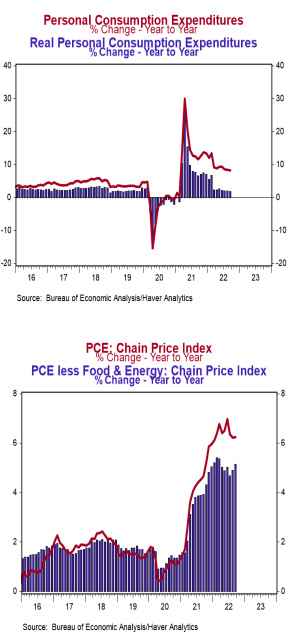- Personal income rose 0.4% in September (+0.5% including revisions to prior
months), matching consensus expectations. Personal consumption increased
0.6% in September (+0.8% including revisions), beating the consensus expected +0.4%. Personal income is up 5.2% in the past year, while spending has increased 8.2%. - Disposable personal income (income after taxes) increased 0.4% (+0.6%
including revisions) in September and is up 3.2% from a year ago. - The overall PCE deflator (consumer prices) rose 0.3% in September, and is up 6.2% versus a year ago. The “core” PCE deflator, which excludes food and energy, rose 0.5% in September and is up 5.1% in the past year.
- After adjusting for inflation, “real” consumption rose 0.3% in September (+0.5% including revisions), and is up 1.9% from a year ago.
Implications:
Income, spending, and inflation all rose in September, as the U.S. economy continues the transition from a stimulus-fueled misadventure toward a slower path of growth. Today’s report is a great example of the shift from the shutdown-induced measures that mainly supported the goods side of the economy, back to the service side, which was discouraged (or outright prohibited) during the pandemic. Consider for a moment that from February 2020 to December of that year, spending on goods rose by more than $300 billion, while spending on services fell by over $500 billion. This government-induced shift caused a massive reallocation of resources: employees, consumer dollars, and investment. Now, as we return to more “normal” spending patterns, the goods side of the economy is feeling the pain. While consumer spending rose 0.6% in September, spending on goods rose a more modest 0.3% and follows declines of 0.8% and 0.4% over the prior two months. This shift will bring with it some layoffs, inventory issues, and a host of other economic ills. Meanwhile the services side of the economy was up a hearty 0.8% in September. In addition to shifting what we could do and where we could do it, the stimulus checks, PPP loans, and extra unemployment benefits of 2020 and 2021 dramatically boosted consumer spending power, more than replacing lost wages. That economic morphine, which was meant to dull the pain of shutdowns, has led to a multi-decade high in inflation and the economic pain that now comes with trying to get that inflation in check. PCE prices – the Fed’s preferred measure of inflation – rose 0.3% in September and are up 6.2% from a year ago. Core prices, which exclude food and energy, rose 0.5% in September and are up 5.1% from a year ago. While energy prices will ebb and flow, core inflation is likely to remain higher for longer than most anticipate. No, we are not in a recession yet, but the Fed is almost very likely to cause one as they try to undue the effects of the policy decisions made over the last two and a half years.





